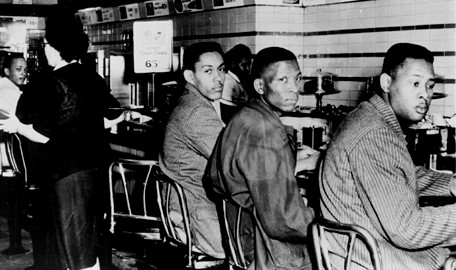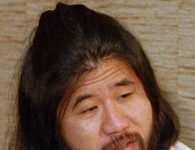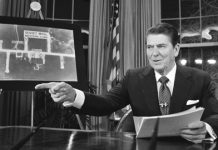On February 1, 1960, four black college students refused to leave a lunch counter where they were denied service, sparking a wave of sit-in protests that spread through much of the South.
The Lunch Counter Sit-in Movement
Jim Crow laws in the South kept public buildings and facilities such as restaurants, libraries, parks, theaters, swimming pools and water fountains segregated. In 1960, four black students at the Agricultural and Technical College of North Carolina (Joseph McNeil, Franklin McCain, David Richmond and Ezell Blair) decided to protest the segregation of lunch counters.
On the afternoon of February 1, the four teenagers walked into the lunch counter at F. W. Woolworth in Greensboro, North Carolina, and purchased several small items before sitting down at the whites-only counter. The New York Times recounted that a black kitchen worker told them “You know you’re not supposed to be in here,” but they remained seated and asked for coffee. A white waitress refused to serve them.
“I beg your pardon, you just served me at a counter two feet away,” McCain said. “Why is it that you serve me at one counter and deny me at another. Why not stop serving me at all the counters.”
In a 2008 interview with NPR, McCain recalled a more positive reaction. An elderly white woman told them, “Boys, I am so proud of you. I only regret that you didn’t do this 10 years ago.”
The four men were prepared to be arrested, but they were allowed to remain seated until closing time. The next day, they returned with a larger group. Their sit-in was covered by the local news and word of their protest spread, inspiring others to launch similar protests in Greensboro. The sit-ins soon spread through North Carolina and then into other states in the South. The sit-in protests in Nashville, Tennessee, were particularly effective.
The student-led sit-ins helped to draw young people into the civil rights movement and create new leaders and organizations. The Student Nonviolent Coordinating Committee (SNCC), which would become an influential organization in the movement, was founded at a conference of sit-in leaders. Civil rights leader Martin Luther King wrote that the sit-ins were an “electrifying movement of Negro students [that] shattered the placid surface of campuses and communities across the South.”
Reactions to the sit-in protesters varied by restaurant. In many places, groups of white men gathered around the protesters to heckle them and there was occasionally violence. “In a few cases the Negroes were elbowed, jostled and shoved. Itching powder was sprinkled on them and they were spattered with eggs,” reported the Times. “At Rock Hill, S.C., a Negro youth was knocked from a stool by a white beside whom he sat. A bottle of ammonia was hurled through the door of a drug store there. The fumes brought tears to the eyes of the demonstrators.” Many managers closed their counters rather than deal with the protests.
The sit-in protests were successful in integrating lunch counters, including the Greensboro Woolworth’s, which integrated in July 1960. Four years later, segregation of public places was made illegal when Congress passed the Civil Rights Act of 1964.
NBC News has a segment on the sit-ins and protests.
Sources in this Story
- New York Times: On This Day
- NPR: The Woolworth Sit-In that Launched a Movement
- Civil Rights Movement Veterans: The Greensboro Sit-Ins
- The Martin Luther King, Jr. Research and Education Institute at Stanford University: Sit-Ins
- NBC News: Today in History: The Greensboro Sit-In
- PBS: The Rise and Fall of Jim Crow
Historical Context: Civil Rights Movement
The findingDulcinea Web Guide to the Civil Rights Movement features links to the best primary and secondary sources on the movement.
PBS’ “The Rise and Fall of Jim Crow” examines the history of the laws of segregation that existed in the South from the end of the Civil War to the end of the Civil Rights Movement.
Other Notable Moments in the Civil Rights Movement
- 1954: Brown v. Board of Education
- 1956: Montgomery Bus Boycott
- 1957: The Little Rock Nine
- 1961: Freedom Rides
- 1963: March on Washington and MLK’s “I Have a Dream” Speech
- 1964: Murders of Schwerner, Chaney and Goodman
- 1965: Selma-to-Montgomery March
- 1968: Martin Luther King Assassinated











